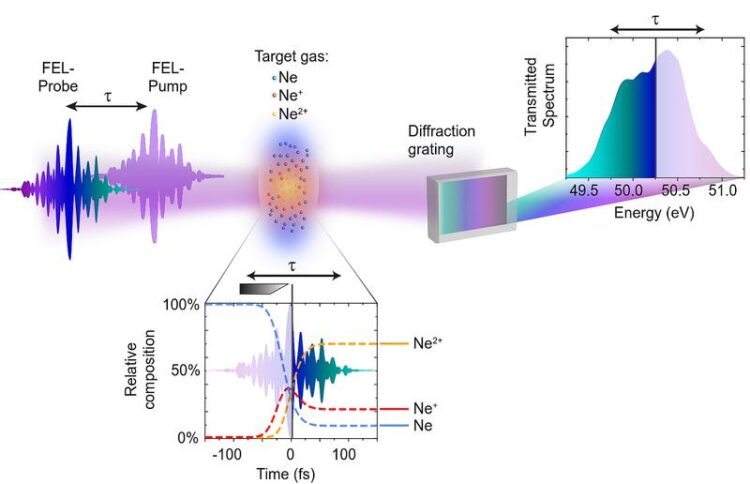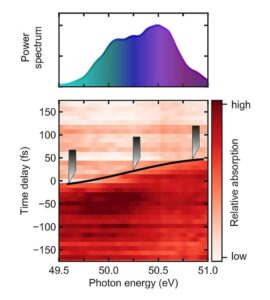Measuring chirps at extremely high frequencies

Fig. 1: Schematic setup of the pump-probe experiment for characterising FEL pulses.
Graphics: MPIK
A new method provides an ultra-fast plasma switch, which temporally cuts off parts of high-frequency light flashes. Carried trillions of times faster by light waves than by sound waves, these flashes sound like birdsong and cricket songs. This understanding opens up new possibilities for optimising state-of-the-art light sources and controlling elementary motions in molecules. [Nature Communications, 28 January 2021]
Ultra-short intense light or laser pulses are an important tool in modern atomic and molecular physics. They allow not only a detailed investigation of the structure of atomic and molecular systems, but also the specific manipulation of the reactions triggered by the interaction with the light field. Novel radiation sources such as free-electron lasers provide light flashes in the far ultraviolet (XUV) to X-ray range and open up new possibilities for this field of research in a revolutionary way.

Graphics: MPIK
Physicists of Christian Ott’s group in Thomas Pfeifer’s department at the Max Planck Institute for Nuclear Physics (MPIK) in Heidelberg have developed a new method for the direct characterisation of XUV pulses in collaboration with an international research team. Here, the focus is on the “chirp” of a laser pulse, during which the frequency of the light oscillation changes temporally. This is of central importance because an atom or molecule reacts very specifically to the light frequency due to its quantum structure and can also dynamically change its structure under the influence of the laser pulse. With a controlled chirp, the frequency could be adapted to this, thereby addressing specific transitions. The experiment for a direct measurement of the chirp of such laser pulses was performed at the free-electron laser FLASH in Hamburg (DESY). The XUV laser pulses used have a duration of about 100 femtoseconds (fs). A femtosecond is the millionth part of a billionth of a second.
For the simultaneous measurement of the temporal (waveform) and spectral (frequency) signature of the laser pulse, a pump-probe setup with two temporally shifted laser pulses was used (Fig. 1): Both pulses are focused onto a dense neon gas and analysed subsequently in a spectrometer dispersing their frequency or photon energy. The first pulse (“pump”) efficiently ionises the target, so that up to 70% doubly charged Ne²⁺ ions rapidly accumulate over time. These are nearly transparent to XUV radiation, while neutral and singly charged neon still absorbs quite strongly. “This plasma target acts like an ultrafast switch for the transmission properties,” explains Thomas Ding, lead author of the publication: “From the second pulse (“probe”), only those parts of the waveform are transmitted – depending on the temporal offset – that see the ionised transparent medium; thus, the waveform is cut off with a temporal knife.”
Fig. 2 shows the experimental result for the relative absorption as a function of the photon energy and the time delay of the two pulses. The frequency spectrum of the relatively broadband pulses is depicted above. In the case shown here, the higher energies or frequencies of the probe pulse arrive ahead in time and are therefore only transmitted at a greater positive delay (i.e., the pump pulse arrives first) than the lower-frequency components that follow later. This is indicated in the figure by the knife symbols. The temporal absorption edge is therefore tilted and slightly curved. From this behaviour, the temporal frequency response in the pulses (chirp) can be directly determined. This is also in good agreement with simulations.
Such a chirp can be heard in the video example with ten consecutive pulses. The timescale was slowed down by a factor of two trillion to transpose the frequencies into an audible range – it sounds like the chirping of a bird or that of a cricket. In each individual pulse, the pitch drops slightly, even though all pulses have different temporal waveforms.
Group leader Christian Ott on the potential of the new measurement method: “It allows direct access to the temporal and spectral signature of the FEL pulses. This is already established for visible light (optical lasers). The realisation in the short-wavelength XUV to X-ray range allows for a much more precise control of individual atoms in larger molecules. This is also a key building block for nonlinear multidimensional spectroscopy in the X-ray range with ultrashort broadband attosecond (X)FEL pulses.”
Wissenschaftliche Ansprechpartner:
Dr. Christian Ott
phone: (+49)6221-516-577
e-mail: christian.ott@mpi-hd.mpg.de
Dr. Thomas Ding
phone: (+49)6221-516-332
e-mail: thomas.ding@mpi-hd.mpg.de
Prof. Dr. Thomas Pfeifer
phone: (+49)6221-516-380
e-mail: thomas.pfeifer@mpi-hd.mpg.de
Originalpublikation:
Measuring the frequency chirp of extreme-ultraviolet free-electron laser pulses by transient absorption spectroscopy
Thomas Ding, Marc Rebholz, Lennart Aufleger, Maximilian Hartmann, Veit Stooß, Alexander Magunia, Paul Birk, Gergana Dimitrova Borisova, David Wachs, Carina da Costa Castanheira, Patrick Rupprecht, Yonghao Mi, Andrew R. Attar, Thomas Gaumnitz, Zhi-Heng Loh, Sebastian Roling, Marco Butz, Helmut Zacharias, Stefan Düsterer, Rolf Treusch, Arvid Eislage, Stefano M. Cavaletto, Christian Ott and Thomas Pfeifer
Nature Communications, DOI: 10.1038/s41467-020-20846-1
Weitere Informationen:
https://www.mpi-hd.mpg.de/mpi/en/public-relations/news/news-item/distorted-atoms MPIK press release “Distorted Atoms”
https://www.mpi-hd.mpg.de/mpi/en/research/scientific-divisions-and-groups/quantu… Group „Excited Atoms and Molecules in Strong Fields“ at MPIK
Media Contact
All latest news from the category: Physics and Astronomy
This area deals with the fundamental laws and building blocks of nature and how they interact, the properties and the behavior of matter, and research into space and time and their structures.
innovations-report provides in-depth reports and articles on subjects such as astrophysics, laser technologies, nuclear, quantum, particle and solid-state physics, nanotechnologies, planetary research and findings (Mars, Venus) and developments related to the Hubble Telescope.
Newest articles

Innovative 3D printed scaffolds offer new hope for bone healing
Researchers at the Institute for Bioengineering of Catalonia have developed novel 3D printed PLA-CaP scaffolds that promote blood vessel formation, ensuring better healing and regeneration of bone tissue. Bone is…

The surprising role of gut infection in Alzheimer’s disease
ASU- and Banner Alzheimer’s Institute-led study implicates link between a common virus and the disease, which travels from the gut to the brain and may be a target for antiviral…

Molecular gardening: New enzymes discovered for protein modification pruning
How deubiquitinases USP53 and USP54 cleave long polyubiquitin chains and how the former is linked to liver disease in children. Deubiquitinases (DUBs) are enzymes used by cells to trim protein…


